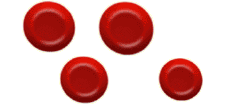
Function: Contain haemoglobin to carry oxygen to the cells.
Adaptation: Thin outer membrane to let oxygen diffuse through easily. Shape increases the surface area to allow more oxygen to be absorbed efficiently. No nucleus, so the whole cell is full of haemoglobin.
Comments
No comments have yet been made